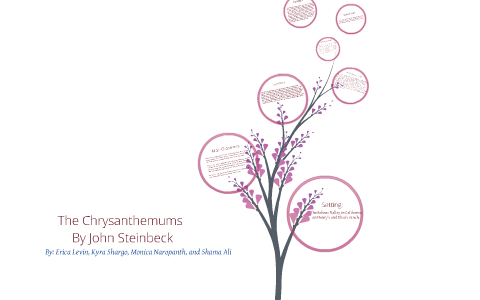Steinbeck published ‘The Chrysanthemums’ in 1938 as part of his collection, The Long Valley, a term often used in reference to the area drained by the Salinas River. The Salinas Valley is a farmer
The Chrysanthemums | Summary, Analysis, Theme, Symbols, Motif – All About English Literature
Nov 21, 2023”The Chrysanthemums” by John Steinbeck is a short story that was published in 1937. The story is set in the Salinas Valley in California in the 1930s and is about a woman named Elisa Allen.
Source Image: quora.com
Download Image
The setting of John Steinbeck ‘s “The Chrysanthemums” has much to do with the character of Elisa Allen. Much like the Salinas Valley of California where she lives that is compared to “a closed pot

Source Image: twincities.com
Download Image
A Gift Discarded in Steinbeck’s “The Chrysanthemums” – Mockingbird Steinbeck displays an extraordinary ability to delve into the complexities of a woman’s consciousness. “The Chrysanthemums” is told in the third person, but the narration is presented almost entirely from Elisa’s point of view. After the first few paragraphs that set the scene, Steinbeck shrugs off omniscience and refuses to stray from

Source Image: opportunities.alumdev.columbia.edu
Download Image
What Is The Setting Of John Steinbeck’S The Chrysanthemums
Steinbeck displays an extraordinary ability to delve into the complexities of a woman’s consciousness. “The Chrysanthemums” is told in the third person, but the narration is presented almost entirely from Elisa’s point of view. After the first few paragraphs that set the scene, Steinbeck shrugs off omniscience and refuses to stray from Summary: “The Chrysanthemums“. “The Chrysanthemums” is a short story by American author John Steinbeck, originally published in 1937 in Harper’s Magazine. It was later added to Steinbeck’s collection of short stories titled The Long Valley, which was published in 1938, and it was adapted into a short film by Steve Rossen in 1990
⭐ The chrysanthemums by john steinbeck analysis. The Chrysanthemums: Themes, Symbolism & Analysis. 2022-11-08
In 1940, he was awarded the Pulitzer Prize for Fiction. By 1943, Steinbeck and Henning divorced, and he quickly married his second wife, Gwyn Conger. Conger and Steinbeck had two sons, John and Thomas, between 1944 and 1946, but were divorced by 1948. Steinbeck married his third and final wife, Elaine Scott, in 1950. PDF) Study Questions on John Steinbeck’s “The Chrysanthemums” (1938) | Ronald Walker – Academia.edu

Source Image: academia.edu
Download Image
The Chrysanthemums by John Steinbeck | Symbolism & Analysis – Video & Lesson Transcript | Study.com In 1940, he was awarded the Pulitzer Prize for Fiction. By 1943, Steinbeck and Henning divorced, and he quickly married his second wife, Gwyn Conger. Conger and Steinbeck had two sons, John and Thomas, between 1944 and 1946, but were divorced by 1948. Steinbeck married his third and final wife, Elaine Scott, in 1950.

Source Image: study.com
Download Image
The Chrysanthemums | Summary, Analysis, Theme, Symbols, Motif – All About English Literature Steinbeck published ‘The Chrysanthemums’ in 1938 as part of his collection, The Long Valley, a term often used in reference to the area drained by the Salinas River. The Salinas Valley is a farmer

Source Image: eng-literature.com
Download Image
A Gift Discarded in Steinbeck’s “The Chrysanthemums” – Mockingbird The setting of John Steinbeck ‘s “The Chrysanthemums” has much to do with the character of Elisa Allen. Much like the Salinas Valley of California where she lives that is compared to “a closed pot

Source Image: mbird.com
Download Image
The Chrysanthemums by Lindsay Marie on Prezi Next Henry leaves, and Elisa turns her attention back to her chrysanthemums. A wagon with a canvas top driven by a large bearded man appears on the road in the distance. A misspelled sign advertises the man’s services as a tinker who repairs pots and pans. The wagon turns into Elisa’s yard.

Source Image: prezi.com
Download Image
Review: The Vigilante | literaryelephant Steinbeck displays an extraordinary ability to delve into the complexities of a woman’s consciousness. “The Chrysanthemums” is told in the third person, but the narration is presented almost entirely from Elisa’s point of view. After the first few paragraphs that set the scene, Steinbeck shrugs off omniscience and refuses to stray from

Source Image: literaryelephant.wordpress.com
Download Image
⭐ The chrysanthemums by john steinbeck analysis. The Chrysanthemums: Themes, Symbolism & Analysis. 2022-11-08 Summary: “The Chrysanthemums“. “The Chrysanthemums” is a short story by American author John Steinbeck, originally published in 1937 in Harper’s Magazine. It was later added to Steinbeck’s collection of short stories titled The Long Valley, which was published in 1938, and it was adapted into a short film by Steve Rossen in 1990

Source Image: opportunities.alumdev.columbia.edu
Download Image
The Chrysanthemums by John Steinbeck | Symbolism & Analysis – Video & Lesson Transcript | Study.com
⭐ The chrysanthemums by john steinbeck analysis. The Chrysanthemums: Themes, Symbolism & Analysis. 2022-11-08 Nov 21, 2023”The Chrysanthemums” by John Steinbeck is a short story that was published in 1937. The story is set in the Salinas Valley in California in the 1930s and is about a woman named Elisa Allen.
A Gift Discarded in Steinbeck’s “The Chrysanthemums” – Mockingbird Review: The Vigilante | literaryelephant Henry leaves, and Elisa turns her attention back to her chrysanthemums. A wagon with a canvas top driven by a large bearded man appears on the road in the distance. A misspelled sign advertises the man’s services as a tinker who repairs pots and pans. The wagon turns into Elisa’s yard.